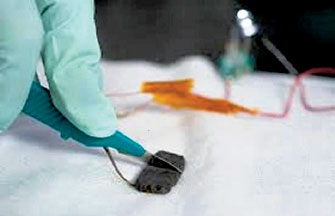Scientists make 'impossible material' Upsalite
Human error solves problem of how to produce world's most efficient
water absorber more cheaply
It is so difficult to make that the researchers who first discovered
it called it the "impossible material".
Now a century later, a team of Swedish scientists have done the
impossible by producing the substance known as Upsalite by accident -
after leaving their equipment running over the weekend. The breakthrough
has far-reaching commercial applications, as Upsalite (named after the
University of Uppsala, where the scientists are based) is the world's
most efficient water absorber, with potential to be used for the removal
of moisture in drug creation and high-tech electronics to cleaning up
huge oil spills.
 A single gram of this elusive white, dry, powdered form of magnesium
carbonate (MgCO3) has an extraordinarily-large surface area of 800
square metres thanks to numerous minuscule pores, each one a million
times smaller than the width of a human hair. A single gram of this elusive white, dry, powdered form of magnesium
carbonate (MgCO3) has an extraordinarily-large surface area of 800
square metres thanks to numerous minuscule pores, each one a million
times smaller than the width of a human hair.
"Upsalite absorbs more water and low relative humidities than the
best materials presently available and can be regenerated with less
energy consumption than is used in similar processes today," said Maria
Stromme, professor of nanotechnology at Uppsala University.
"This, together with other unique properties of the discovered
impossible material, is expected to pave the way for new sustainable
products in a number of industrial applications," she said.
Other uses include ice hockey rinks, warehouses, the collection of
toxic waste or chemical spills and odour control.
MgCO3 is also about as dry as a material can get, a property which,
combined with a huge relative surface area that is inundated with pocket
pores, makes it the world's best mop.
The only problem is that, until now, this absorbent form of magnesium
carbonate could only be produced by a process that is so expensive and
involves so much heat that it wasn't remotely feasible to use it. While
other members of the so-called "disordered carbonates" family could be
produced more cheaply and simply - by bubbling carbon dioxide through a
mixture containing alcohol - a group of German researchers claimed in
1908 that this method couldn't be used to make dry MgCO3. And so they
dubbed it the "impossible material".
The irony is that although the Uppsala team had been trying to create
the impossible material, they had been going about it the wrong way.
"A Thursday afternoon in 2011, we slightly changed the synthesis
parameters of the earlier employed unsuccessful attempts, and by mistake
left the material in the reaction chamber over the weekend.
- The Independent
|


